 THE ECONOMY OF THE
NORTH
THE ECONOMY OF THE
NORTH
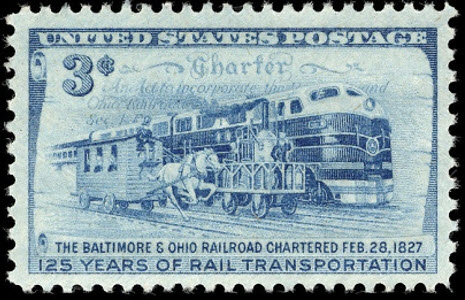
U.S.
Postage Stamp Commemorating the Anniversary of the Baltimore and Ohio Railroad
Unit
Overview
Although
Americans took great pride in their victory over Mexico, the sectional rivalry
between the North and the South continued to intensify.† Because they built different economies, both
regions were determined to protect their interests.† In the North, advancements in technology,
transportation and communication encouraged the development of new industries
and the expansion of established ones.†
During the 1850s, the population of the northeast grew rapidly due to
the ongoing arrival of large numbers of immigrants.† They provided a ready supply of cheap labor
in the factories but were often subjected to discrimination and prejudice.† African-Americans living in the North also
faced unfair treatment and were denied the right to vote in most states.† Letís see how it all happened.†
Northern
Society
Although
many northern industries made large profits by the mid-nineteenth century, the
regionís wealth was not equally distributed.†
The upper class made up 10%
of the Northís population, but its members owned 40% of the entire nationís
assets.† This elite group included
bankers, shippers, manufacturers and merchants.†
They owned factories, mines, railroads and other advantageous
businesses. †Their families vacationed in
Europe, belonged to exclusive social clubs and attended college, a privilege
available to only about 1% of Americans at that time.† Many upper-class northerners maintained
mansions in the city and at the seashore or in the mountains.
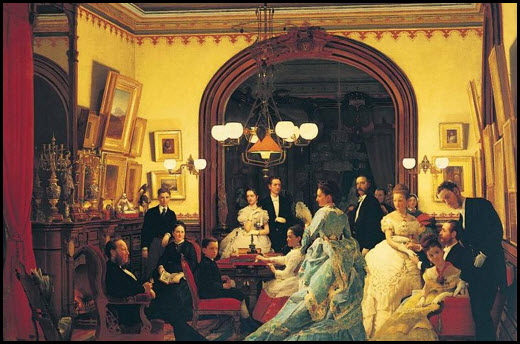
Going to the Opera:† Seymour Joseph Guy, 1874
About
40% of the Northís citizens belonged to the middle class.† It mainly
consisted of small-business owners, lawyers, doctors, religious leaders and
farmers who owned land.† Members
belonging to this social category generally enjoyed a comfortable lifestyle and
were able to afford the newest conveniences, such as indoor plumbing and central
heat.† Those who could finance it often
sent their children to private schools with the hope of making connections with
the upper class.†
The lower class composed the remaining 50%
of the Northís society.† Agricultural
workers that did not own property and manual laborers in factories were part of
this group.† For the most part, they had
little control over their working conditions, salaries or hours.† Most put in twelve or fourteen hours daily
six days a week.† Industrial accidents
were common, and those injured on the job were simply fired.† Children of lower-class families often went
to work at an early age.† This left them
little time for school or play.† Without
training or education, most were destined to earn low wages and had few
opportunities to escape poverty.
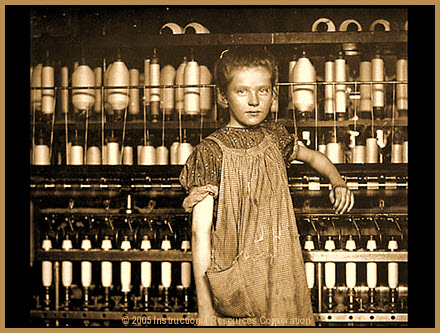
A Young Textile Worker in New Hampshire
In
the 1830s, factory employees began organizing and demanded better
conditions.† Groups of skilled workers
involved in the same trades formed trade
unions, such as the General Trades
Union of New York.† Unskilled workers
followed their example.† To put pressure
on employers for higher wages and shorter work days, workers engaged in strikes.† During a strike, employees refused to work
and tried to disrupt production or service.†
Strikes were illegal in the early 1800s, and workers were fired for
participating in them.† However, a
Massachusetts court ruled in 1842 that workers did have a right to carry out
these activities.† Nonetheless, many
years passed before a workerís right to strike was actually respected.
![]() † Go to Questions 1 through 6.
† Go to Questions 1 through 6.
A
Growing Population
Between
1845 and 1860, the number of immigrants entering the United States steadily
increased.† American manufacturers in the
Northeast welcomed the new arrivals because many of them were willing to work
long hours for little pay.† By 1860, the
population of the twenty-three states that defined themselves as the North was
21 million.† The southern states, on the
other hand, accounted for a little over 9 million people, 3.5 of which were
enslaved Africans.† The map below shows
the population distribution throughout the United States in 1850.
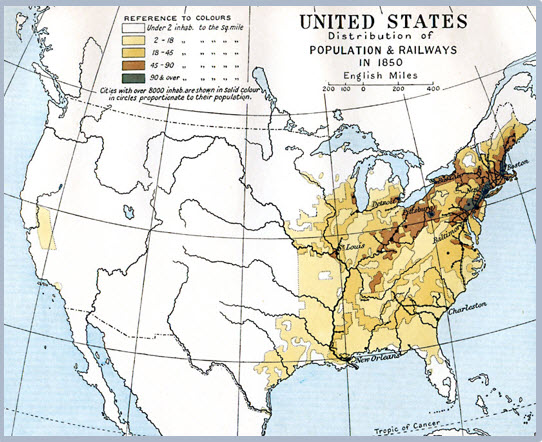
Map Courtesy of FCIT and the Roy Winkelman Collection
The
largest group of immigrants came from Ireland.† A census taken in 1850 noted that there were
961,179 people in the United States that were born in Ireland.† That number exceeded 1.5 million by
1860.† Irish immigrants lived primarily
in New York, Massachusetts, Pennsylvania, Indiana, Ohio and New Jersey.† The men found jobs in factories, in coal
mines and on railroads.† Women accounted
for nearly half of the Irish who came to America.† Some found employment in industry; others
worked as maids, cooks and nannies in the households of the upper class.† The video listed below explains more about
the arrival of these future Americans and their impact.
![]() † Go to Questions 7 through 10.
† Go to Questions 7 through 10.
Prejudice
and Discrimination
Immigrants
brought with them their languages, religions, customs and ways of life.† Many of their practices eventually became
part of American culture, but some viewed immigration as a threat to the
futures of native, or American-born, citizens.†
Those who opposed the arrival of large numbers of foreigners were called
nativists.† Because many immigrants accepted low
salaries, the nativists often blamed them for keeping wages low.† They also claimed that foreigners increased
crime and disease in cities like New York and Boston.
The
anti-immigration sentiment led to the formation of the American Party.† When asked
about their organization, members frequently responded by saying, ďI know
nothing.Ē† Therefore, the group became known
as the Know-Nothing Party.† The Know-Nothings campaigned for stricter
immigration laws and tried to ban foreign-born citizens from running for public
office.† However, the movement collapsed
when the party split over the issue of slavery.
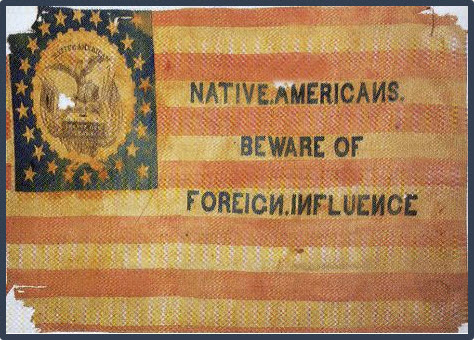
Flag
of the Know Nothing Party:† 1850
Free
African Americans living in the North were also subjected to prejudice and
discrimination.† Although slavery had
been outlawed by most northern states by 1830, African Americans were generally
denied the right to vote in public elections.†
Communities did not permit them to use public facilities and demanded
that they have separate hospitals and schools.†
The overwhelming majority of African Americans living in the North were
extremely poor.† However, there were some
notable exceptions.† In 1845, for
example, Macon B. Allen became the
first African American in the United States to practice law.† Henry
Boyd established his own furniture-manufacturing company in Cincinnati,
Ohio, while John B. Russwurm and Samuel Cornish founded Freedomís
Journal, the countryís first African-American newspaper in New York
City.† At the same time, abolitionist, or anti-slavery,
organizations formed in many cities and towns throughout the North.† These societies included black and white
members who hoped to end the practice of slavery in all regions of the United
States.†
![]() †† Go to
Questions 11 through 13.
†† Go to
Questions 11 through 13.
Connecting
North and West
Although
better roads and canals improved transportation in the United States, northern manufactures
and mid-west farmers continued to look for cheaper, faster ways to exchange
goods.† Following the British example,
Americans began experimenting with railroads in the 1830s.† The Baltimore
and Ohio was the first U.S. railroad line.†
It offered regular passenger service along a thirteen-mile track with
carriages pulled by horses.† Tom
Thumb, the first American steam locomotive, was designed and built by Peter Cooper.† Although it quit working in its first race
with a horse-drawn train, steam locomotives quickly became a reliable source of
power.† Soon a railway network connected
the major cities in the Northeast and stretched into the Midwest.† Grain, dairy products and livestock moved
from mid-west farms to the cities along the eastern seaboard.† Because manufactured goods traveled faster
and more cheaply by train, producers offered lower prices.† This made their products more affordable for
settlers in the West.
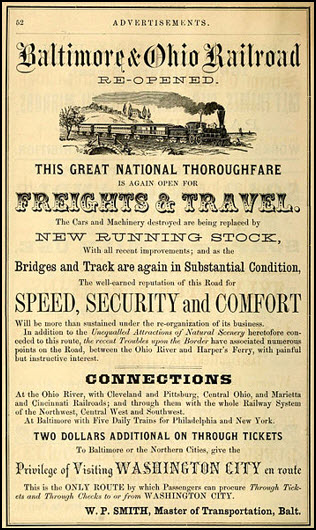
Poster for the Baltimore and Ohio Railroad
Canals
and railroads engaged in a bitter competition for customers, but the railroads
proved superior in service.† They could
be built anywhere and could operate year-round.†
In 1840, the United States had 3000 miles of railroad track.† By 1860, 31,000 miles of track, mostly in the
North and Midwest, had been built.† In
1869, railroad companies completed the transcontinental railroad line, which
ran from the Atlantic to the Pacific coast.
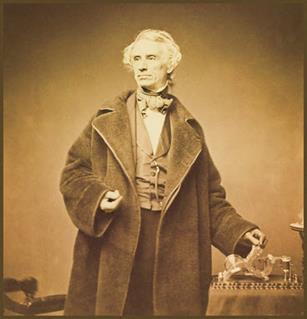
Samuel Morse and a Telegraph Receiver
Faster
travel inspired faster communication.† Samuel Morse, an American inventor,
developed the electric telegraph.† For
the alphabet, he substituted a code of dots and dashes that could be typed and
transferred through a network of telegraph wires.† In 1837, he demonstrated his idea by typing a
message from a terminal in Washington D.C.†
A few moments later, an operator in Baltimore sent the same message to Morse
as a reply.† Soon words were flying back
and forth between the two cities.†
Americans immediately formed telegraph companies and strung telegraph
wires across the country.† Newspapers
used the telegraph to send stories over great distances.† Information that once took weeks to travel
from East to West arrived in a few moments.†
For example, election results were spread rapidly across the country
with the telegraph.† Railroads were able
to send information concerning delays or changes in schedules to train stations
along their lines.
 † Go to Questions 14 through 17.
† Go to Questions 14 through 17.
Revolutionizing
Farming
As
railroads provided farmers with access to more markets for their crops,
mechanized farming equipment offered the ability to increase the size of their
harvests.† When they first came to the
Great Plains, settlers feared that their wooden plows were not strong enough to
break up the sod for planting.† John Deere solved this problem in 1837
with the invention of the steel-tipped plow.†
This sturdy, metal tool easily cut through the hard-packed soil and
simplified the sowing of wheat, a grain that grew in abundance once it took
root.

A Re-enactment of the Use of the McCormick Reaper
Traditionally,
farmers had harvested their crop by cutting it with handheld sickles.† This was a slow, time-consuming task.† It also limited the amount of wheat that a
farmer could manage.† That changed when Cyrus McCormick designed and built the
mechanized reaper.† This invention
enabled a single farmer to cut more wheat than five farmers working by hand.† Learn more about the impact of technology on
the lives of Americans by watching the video below.
![]() †
Technological Developments during the Jacksonian Era
†
Technological Developments during the Jacksonian Era
Settlers
on the prairie were able to grow wheat for shipment as a cash crop to the
Northeast.† Then, farmers in the
Northeast concentrated on growing fruits and vegetables, products that were
better suited to the regionís soil and climate.†
These changes resulted in what has been called the Marketing Revolution.† Learn
more about its effect on the American economy by watching the video listed
below.
The
new economy had both positive and negative results.† Although farmers and factory owners profited
from the growth of agriculture and manufacturing, there were sometimes severe
economic downturns and heavy losses.†
Farmers were dependent on weather conditions and had no control over the
fees charged by the railroads.† A lack of
government regulation left workers and small business owners at the mercy of
wealthy industrialists.† By the 1930s,
reliance on wheat as the cash crop of the Great Plains had destroyed the areaís
system of natural grasses.† This was a
major factor in creating the Dust Bowl, an ecological disaster that took years
to correct.
 † Go to Questions 18 through 20.
† Go to Questions 18 through 20.
What
Happened Next?
The
economy of the South also prospered between 1820 and 1860.† A boom in cotton sales made agriculture
profitable, and most southerners believed that the trend would continue.† To meet the demand, planters increased their
reliance on slave labor and were determined to continue the practice of
slavery.† Before examining the economy of
the southern states in the following unit, review the names and terms in Unit
29; then, complete Questions 21 through 30.
 † Go to Questions 21 through 30.
† Go to Questions 21 through 30.
†† †††
 |
| Unit 29 Railroad History |
| Unit 29 The Irish Immegrant Experience Article and Quiz |
| Unit 29 What's the Big Idea? Worksheet |